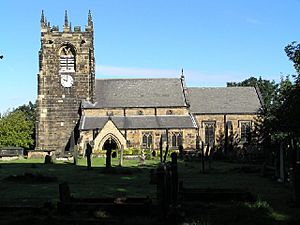Church of St Mary the Virgin, Beighton facts for kids
The Church of St Mary the Virgin is a really old and important church in Beighton, which is a part of the city of Sheffield, England. You can find it just off High Street. It's the main church for the Beighton area and is considered a special, historic building (a Grade II* listed building). Even though the church we see today has parts from the Medieval times, the very first church here was built way back in the 1100s! It's named after Mary, who was the mother of Jesus.
Contents
A Look Back: History of the Church
Beighton was mentioned in a famous old book called the Domesday Book in 1086, but it didn't say anything about a church there. People think St. Mary's Church was first built around 1150. We know this because workers found parts of an old, round arch from the Norman period (a time after the Norman Conquest of England) during repairs in the late 1800s. This arch would have been in the chancel, which is the part of the church where the altar is.
The first time the church was written about was in a document from the time of King Edward I (between 1272 and 1307). Back then, the church was actually named after Saint Radegund. We don't know exactly when the name changed to St Mary, but even in 1557, people still talked about "the churchyard of Virgin Radegund at Beighton."
Building Through the Ages
The oldest part of the church you can see today is probably the tower arch, which might be from the 1200s. The north side of the church (called the north aisle) was added in the 1400s. There was a lot of building work and changes around the late 1300s. During this time, a pointed arch was added to the chancel, and new rows of arches (called nave arcades) were built in the main part of the church.
More repairs happened in 1773. But by the 1860s, the church was in bad shape. So, a new minister, Reverend George Antrobus, hired an architect named Samuel Rollinson from Chesterfield. Rollinson led a big project to rebuild and fix up the church between October 1867 and December 1868.
During this work, they took down and rebuilt the walls of the chancel and the south aisle. They also removed the windows high up in the nave (called Clerestory windows) and took down a balcony at the back of the church. The old box pews (which were like private boxes) were replaced with new bench pews, allowing more people to sit – up to 291!
Interesting Features of the Church
- The North Door: This door, sometimes called the "Devil's door", was once blocked up but later reopened. Long ago, people believed that leaving this door open during baptisms would let out any evil spirits from the child.
- Old Gravestones: On the north side of the chancel, there are two old gravestones. One of them belongs to the Jermyns, a rich family who owned land in Beighton and nearby areas.
- The Squint: There's a special hole cut into the wall between the chancel and the nave. It's called a Hagioscope or "squint." This allowed people who couldn't see the altar directly to still watch the priest during the service.
- Brass Memorials: On the south wall of the nave, you can find two special brass plates. These mark the resting places of William Jessoppe, who was a vicar (a type of minister) of Beighton and died in 1667, and Robert Jessoppe, who died in 1753.
- The Rood: The rood (a cross or crucifix, often with figures of Mary and John, placed above the chancel arch) in the church was designed by a famous artist named Ninian Comper.
In December 2006, experts from Ed Dennison Archaeological Services Ltd watched carefully during some internal repairs and when the church's outdoor drainage system was replaced. They didn't find any signs of the very first medieval church. However, they did find something exciting: an early stone floor that was last seen in 1816 and had been buried during the 1867 restoration! This floor is thought to be from the early 1500s.
Images for kids



